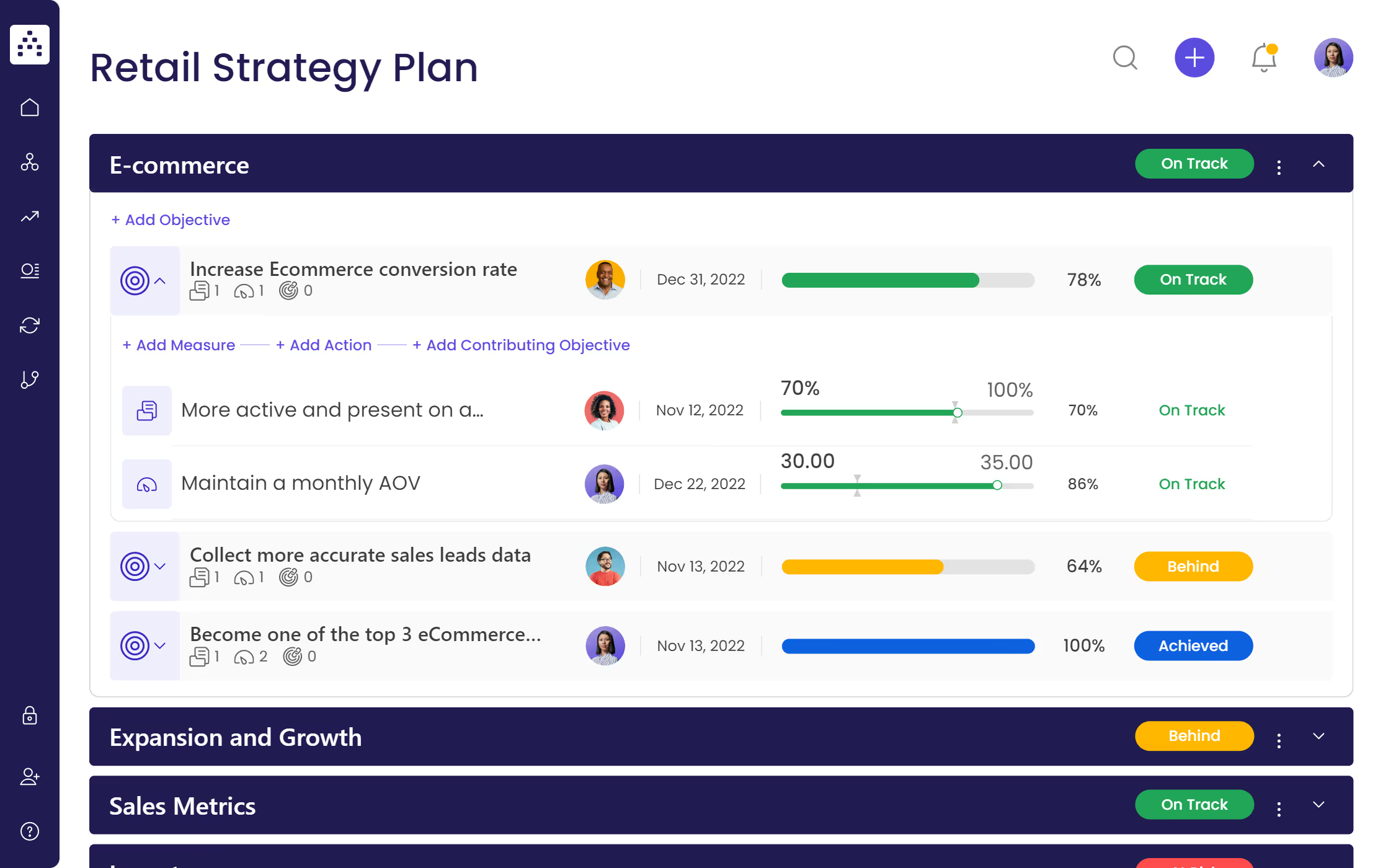What is a Retail strategy?
A retail strategy is a holistic marketing plan with the intention of reaching the customer base through the use of a product or service. The main function of such a template is to help organizations like yourself meet the needs and wants of the customer in a straightforward and strategic way, whilst formulating a retail strategy plan.
What's included in this Retail strategy template?
- Retail Vision Statement
- 4x Retail Values
- 5x Retail Focus Areas
- 15x Retail Objectives
- 18x Retail Projects
- 22x Retail KPIs
Who is this Retail strategy template for?
At Cascade, we understand that every organization is not the same and as such, this impacts their target audience, fundamental purpose, and values. Bearing this in mind, when it comes to selling a product or service, not every retailer has the same intentions. Implementing this Retail strategy template requires a set of standard focus areas, projects, and measurable targets to be created. These are then used as a way in which organizations can track and measure their level of performance, productivity, and how effective their marketing strategy really is. Such a retail strategy template can be used by everyone part of the distribution and supply chain from the producers, manufacturers, whole-sellers, and intermediaries. Third-party buyers and sellers can also use such a template as well as franchise and merger ventures.
How is this Retail strategy template relevant to your organization?
It is important to note that each template can be customized to suit the end need of your organization. Whilst Cascade has created guidelines and specific areas within the template, you have the ability to change and manipulate this information to suit your needs.
1. Define clear examples of your focus areas
A focus area is a particular viewpoint that groups certain requirements set out by an organization. A recommendation from the Cascade team would be to create 4-5 key focus area which you feel are most important to address when creating your Retail Strategy. The next step would be to ask yourself: Why is this focus area important to me? What is the benefit of focusing on this viewpoint from a customer's perspective? and of course What is the monetary benefit of investing in such a focus area? This process is useful in identifying the key area which needs prioritization which in turn can become focus areas of the strategy.
For example, the focus areas for a Retail strategy for a brand like Target could be customer experience, sales metrics, expansion and growth, inventory.
These focus areas have to be specific to what your company will want to be addressing and targeting i.e. for customer experience the focus is on the end-user who purchases that product or service. Nonetheless, it is important to not be overly specific when creating a focus area as you need to be able to generate at least 3 objectives you and your team can successfully work towards.
2. Think about the objectives that could fall under that focus area
A strategic objective usually has to be specific and measurable to cause enough impact and effectively explain what you want to achieve.
An example objective that could fall under the focus area of customer experience: Improve performance of support team by September 2021.
This objective includes a team frame and a list of resources that are involved by stating that the support team is in fact the employees at Target and the fundamental intention is to improve the service delivered to the customer. Achieving this objective brings us to our next point: KPIs.
3. Set yourself measurable targets (KPIs) to tackle the objective
A KPI is a key performance indicator that is measurable and evaluates the success rate of an organization in relation to the task at hand. KPI’s can be very industry-specific or broad and applicable across multiple industries. With reference to the Retail strategy template, Retail KPIs have to clearly track performance to create the next set of action steps.
An example of a Retail KPI addressing the performance of the support team can be: Decrease the average turnaround time for normal complaints From the above example, using that KPI will also require a measurable time frame for achieving the target as well as the turnaround time for the complaints.
Check out a few examples of some retail KPIs we came up with, their definition, and how your company can incorporate and use them in your strategy template.
4. Implement related projects to achieve the set KPIs
Projects are ways in which the objective can be achieved, but more so, closely tie in with ways in which organizations can make sure they are working towards their KPIs. Regarding the Retail strategy at hand, it is important to ensure that the projects address the central concept of the KPI at hand.
Project example: Improve store layout A project as simple as improving the store layout can cause a huge change to an organization's consumer base as it impacts in-store ergonomics, visuals and can potentially draw more customers in. Respectively to achieve this project, you will have to have a few KPIs that you can employ.
5. Utilize Cascade tools to track and visualize performance
Under Cascade, the creation of dashboards and snapshots are available. Predominantly focusing on dashboards, these visual tools can assist in graphically tracking the progress of set KPIs and projects. By adding a 'widget' you have the ability to graph out your measurable target and more specifically choose which target you want to focus on.
Dashboards are hugely useful as a way of keeping your team accountable and on top of their tasks at hand. Under 'project' dashboards, you can graphically view and compare which of your retail projects are on track and which ones are not. This can be accessible by the whole team and can be a good motivator to boost individuals to try and achieve their task/ project at hand.


